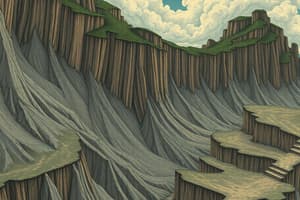Podcast
Questions and Answers
What is erosion?
What is erosion?
- The process of removing soil, rock, or dissolved material from one location and transporting it to another location (correct)
- The process of adding soil, rock, or dissolved material to one location and leaving it in the same location
- The process of removing soil, rock, or dissolved material from one location and leaving it in the same location
- The process of adding soil, rock, or dissolved material to one location and transporting it to another location
What are the agents of erosion?
What are the agents of erosion?
- Rainfall, bedrock wear in rivers, coastal erosion, glacial plucking, areal flooding, wind abrasion, groundwater processes, and mass movement processes (correct)
- Rainfall, bedrock wear in rivers, coastal erosion, glacial plucking, areal flooding, and wind abrasion
- Rainfall, bedrock wear in rivers, coastal erosion, and glacial plucking
- Rainfall, bedrock wear in rivers, coastal erosion, glacial plucking, areal flooding, wind abrasion, and groundwater processes
What is the primary cause of land degradation?
What is the primary cause of land degradation?
- Human activities
- Water and wind erosion (correct)
- Chemical erosion
- Glacial plucking
What are the four main types of soil erosion produced by rainfall?
What are the four main types of soil erosion produced by rainfall?
What is mass wasting?
What is mass wasting?
What are the primary factors affecting erosion rates?
What are the primary factors affecting erosion rates?
What is the main process of shoreline erosion?
What is the main process of shoreline erosion?
What is the effect of excessive erosion?
What is the effect of excessive erosion?
What is the effect of human activities on erosion rates?
What is the effect of human activities on erosion rates?
Flashcards are hidden until you start studying
Study Notes
Natural Processes that Remove Soil and Rock:
-
Erosion is the process of removing soil, rock, or dissolved material from one location on the Earth's crust and transporting it to another location where it is deposited.
-
Agents of erosion include rainfall; bedrock wear in rivers; coastal erosion by the sea and waves; glacial plucking, abrasion, and scour; areal flooding; wind abrasion; groundwater processes; and mass movement processes in steep landscapes like landslides and debris flows.
-
Human activities have increased the rate at which soil erosion is occurring globally by 10-40 times.
-
Excessive erosion leads to decreases in agricultural productivity and ecological collapse, and sedimentation of waterways and eutrophication of water bodies, as well as sediment-related damage to roads and houses.
-
Water and wind erosion are the two primary causes of land degradation, responsible for about 84% of the global extent of degraded land.
-
Rainfall produces four main types of soil erosion: splash erosion, sheet erosion, rill erosion, and gully erosion.
-
Valley or stream erosion occurs with continued water flow along a linear feature, and bank erosion is the wearing away of the banks of a stream or river.
-
Shoreline erosion primarily occurs through the action of currents and waves, with hydraulic action, wave pounding, abrasion, corrosion, and bioerosion being the main processes.
-
Chemical erosion is the loss of matter in a landscape in the form of solutes, and glaciers erode predominantly by three different processes: abrasion/scouring, plucking, and ice thrusting.
-
Wind erosion is a major geomorphological force, especially in arid and semi-arid regions, and a major source of land degradation, evaporation, desertification, harmful airborne dust, and crop damage.Erosion and Mass Wasting: An Overview
-
Erosion can be of two primary types: deflation and abrasion.
-
Deflation is divided into three categories: surface creep, saltation, and suspension.
-
Wind erosion is much more severe in arid areas and during times of drought.
-
Mass wasting is the downward and outward movement of rock and sediments on a sloped surface, mainly due to the force of gravity.
-
Mass-wasting processes are always occurring continuously on all slopes.
-
Submarine sediment gravity flows can result in erosion of the ocean floor to create channels and submarine canyons.
-
Climate, vegetative cover, topography, and tectonics are the primary factors affecting erosion rates.
-
Human land development, in forms including agricultural and urban development, is considered a significant factor in erosion and sediment transport.
-
Mountain ranges can take many millions of years to erode to the degree they effectively cease to exist.
-
If the rate of erosion is higher than the rate of soil formation, the soils are being destroyed by erosion.
-
Excessive erosion causes both "on-site" and "off-site" problems.
-
Water and wind erosion are the two primary causes of land degradation.
Studying That Suits You
Use AI to generate personalized quizzes and flashcards to suit your learning preferences.




